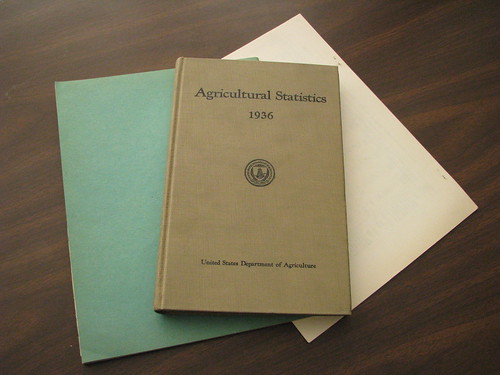
This post is part of the Science Tuesday feature series on the USDA blog. Check back each week as we showcase stories and news from USDA’s rich science and research portfolio.
Did you know that more than 11 million Americans worked on farms in 1930, of which 8.3 million were family workers? Compare that to the fewer than 1.5 million workers employed in agriculture during the peak harvest months of 2011.
Every year, the Department of Agriculture releases a reference book of major agricultural statistics for the United States and countries around the world. It is a one-stop location for annual production, consumption, trade, and price data for all sorts of crops and livestock, as well as spending for government programs, farm economics, and lots of other statistics important to our country’s agricultural system. Agricultural Statistics has a long history of publication, and is an important archive for researchers to study the history of U.S. farming.
Now anyone can download PDF files of Agricultural Statistics dating back to 1936, its first publication, for free on the National Agricultural Statistics Service website. These volumes detail U.S. agricultural production for much of the 20th century, including the Dust Bowl and World War II. They provide a small glimpse into our country’s past, how American farmers worked their fields, the fruits of their labors, and how that work shaped the world then and now. There are so many facts to be uncovered! For instance:
- U.S. egg exports skyrocketed from 5 million dozen in 1940 to 153 million dozen in 1941, the same year the Lend-Lease policy was enacted to provide food aid to Britain and other allies during World War II. By 1944, that number was nearly 700 million dozen!
- In 1933, hybrid corn seeds made up only one-tenth of 1 percent of the national crop. Within ten years, that proportion reached 50 percent, and by 1956, more than 90 percent of the national corn crop was from hybrid seeds.
- Iowa harvested 2.36 billion bushels of corn in 2011, more than the entire U.S. corn harvest of 1935.
- Once staples of American farms, horse and mule populations fell from 18.7 million in 1930 to 3.1 million in 1960, after which the statistic was discontinued.
Agricultural Statistics is a compilation of data produced by multiple agencies within USDA. The volumes from 1936 to 2012 are available at www.nass.usda.gov/Publications/Ag_Statistics/index.asp in partnership with Cornell University’s Mann Library. Whether you need them for research or are just curious about our country’s farming history, the newly digitized historic volumes are a valuable addition to the statistical literature available to the public.
